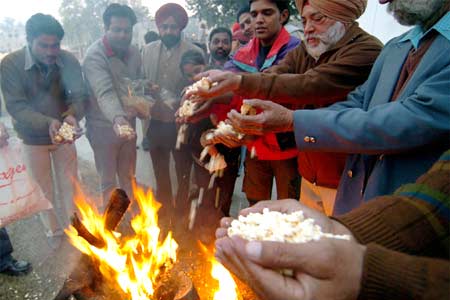 Makar
Makar means Capricorn and Sankranti is transition. There is a sankranti every month when the sun passes from one sign of the zodiac to the next. There are twelve signs of the zodiac, and thus there are twelve sankranti’s as well. Each of these sankranti’s has its own relative importance but two of these are more important - the Mesh(Aries) Sankranti and the most important, the Makar(Capricorn) Sankranti. Transition of the Sun from Sagittarius to Capricorn, during the winter solstice in the northern hemisphere is known as Makar Sankranti. From this day begins the six-month long Uttarayana, considered very auspicious for attaining higher worlds hereafter.

Makar Sankranti is celebrated all over India but with different name. There is also remarkable difference in the method of celebrations.

In Tamil Nadu, Makar Sankranti is celebrated as
Pongal - a harvest festival.
Pongal is a highly revered festival celebrated in Tamil Nadu to mark the harvesting season. An important festival in India, Pongal is celebrated by offering prayers to the Sun God. Pongal gifts are exchanged among family members, relatives and friends. Houses are cleaned, and all maintenance jobs are done before this festival. Held in the middle of January, it is a time when the people of Tamil Nadu get ready to thank God, Earth and their cattle for the wonderful harvest they have reaped. During the four-day pongal festival, different varieties of Rangoli are drawn in front of the houses early in the morning.

In Andhra Pradesh, it is Pedda Panduga.
In Kerala, Makar Sankranti marks the end of the pilgrimage to the famous Sabarimala Temple.
In West Bengal, it is Pithey parban – a harvest festival – and there is also the famous Ganga Sagar mela.
In Assam, it is Bhogali Bihu.
In Punjab, Jammu and in some parts of Himachal Pradesh and Haryana, it is Lohri.
In Central India, it is Sakarat.
In Orissa, it is Makar Mela.
Call it Lohri, Pongal or Sankranti, the festival conveys the same message — the bond of brotherhood and the spirit of oneness should prevail despite all odds.

 Traditional paintings on paper from Madhubani, Mithila in India. Originally they were painted on the ground and mud walls of the houses as an invocation to the gods who inhabited the images if they were well painted. The three chief gods of Hinduism, Brahma, Vishnu and Shiva are frequently depicted as well as Krishna and the female deities Parvati, Kali and Lakshmi.
Traditional paintings on paper from Madhubani, Mithila in India. Originally they were painted on the ground and mud walls of the houses as an invocation to the gods who inhabited the images if they were well painted. The three chief gods of Hinduism, Brahma, Vishnu and Shiva are frequently depicted as well as Krishna and the female deities Parvati, Kali and Lakshmi.































